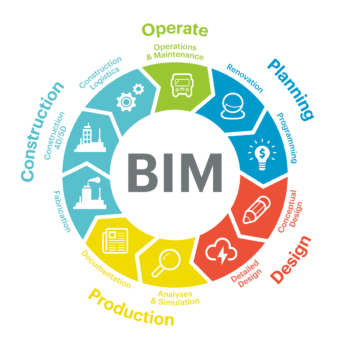
BIM: What should be the next step?
“More than just modelling, BIM is an asset for managing your data!”
Geneviève Crête, Partner / Senior BIM/VDC Project Manager – Information Governance / Project Management
We often confuse BIM and 3D modelling. However, BIM is much more than just modelling: it is a complete process from the definition of user needs to project completion. For several years now, the BIM process based on modelling has become the standard in North America. The adoption of BIM in Quebec has evolved rapidly since the digital transition (2008). The adoption of BIM mainly started with professionals (architects, engineers) through the integration of 3D modelling in project delivery steps.
Across Canada, we have excellent BIM managers and trainers in terms of analysis tools, 3D modelling and modelling solutions in several sectors of activity. We can therefore presume that the level of maturity for 3D modelling has been achieved or is on the way to be in regard to project design.

With this level of maturity achieved, the question we may ask is: “Have we reached the full potential of this process?” Basic modelling allows for visualizing construction intentions and provides part of the solution for integrating asset management data. A 3D model or digital twin addresses the need for the visualization and understanding of spaces, but without structured data, it cannot be integrated into an operational asset management strategy.
Therefore, for a company to obtain real added value from the data generated through the BIM process, it must have a structured, up-to-date, and verified data management strategy. This strategy must be part of its business processes in order to obtain minimally a clear vision of data life cycle, a source of information that allows for making enlightened decisions, and a centralized data bank that facilitates information follow-up at all activity levels.
Our BIM managers have a very good knowledge of modelling and the application of BIM in project delivery. However, they alone cannot ensure the integration of the process at all stages of project management. The involvement of business owners and project teams is one of the greatest assets in achieving the long-awaited potential of BIM.
Here are a few elements to ponder:
Some questions need to be asked to establish a roll-out strategy:
- Have you integrated BIM into your business practices?
- Have you recognized the full potential of the BIM process and what it can bring to your business?
- Do you have a good understanding of how BIM fits into project management steps?
- What is your understanding of BIM integration into your project management processes?
- How can you modify your project management processes to optimize the BIM process in order to achieve the value added promised by the use of a BIM approach?
In light of the digital transformation, the BIM process is becoming a solution to ensure optimization and efficiency of our projects in Quebec. We must therefore take the time to understand the full potential of this process and ask ourselves the right questions as to where we are and how we, as business owners or professionals, can participate in its integration.

“Sound project management is a crucial success factor for any project, and this is our specialty.”
Yves Roland Mondou, Eng.
Senior Vice President, Project Management
